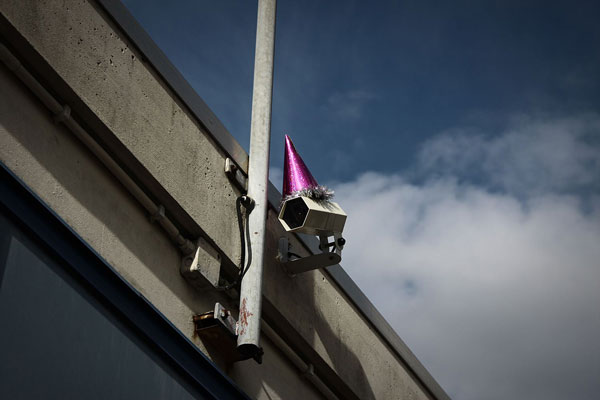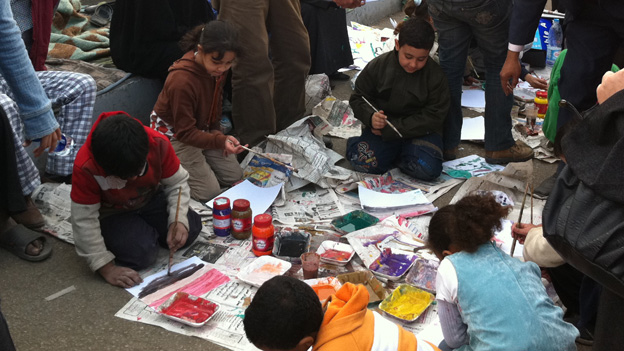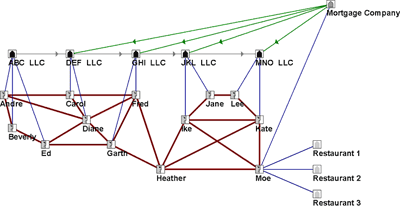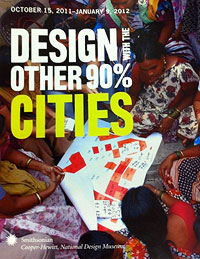cities

Tahrir, Revolution, and Design
Stunning photos today of the millions of Egyptians out in the streets to commemorate the start of the revolution a year ago that turned out Mubarak — and to demand transition from military to civilian rule.
A few things have been written on the supporting role of design in the revolution and the urban landscape as both site and medium of protest:
- The role
of protest signage
- Graffiti and murals
- Planning, public squares and cities as tools of rebellion
- Flyers, manifestos and ephemera
- Cellphone cameras and social media
- Even product labeling.
But I think my favorite detail is in this annotated overview of Tahrir square by BBC News.
The authors of direct action (particularly in West Asia and North Africa) are often depicted as a rowdy mob of thugs. But instead of the usual sea of angry Arab men so often shown by the mainstream media, the photo shows a kindergarten set up in the square. Schools in Cairo had been closed during the protests, but many mothers wanted to attend the demonstration as well. So demonstrators organized an impromptu kindergarten.
The image captures the spirit of mutual support that sprang up around the occupation. And my favorite detail: the newsprint under the paintings to keep the square, the city and country they love, free from spills. No random acts of violence here, but using the city to create something new, a different future, with hope and love.


Design with the Other 90 Percent: Cities

I would argue that the biggest events in design for social impact this year were not in sustainable design, service design, or design innovation, but in civic space: people rising up, occupying their cities, streets, and public squares, and using graphics, their bodies, and their cities as both place and medium to express themselves and shake the pillars of state across west Asia, north Africa, and southern Europe.
So it’s with some interest that I’m looking forward to Design with the Other 90 Percent: Cities, an upcoming exhibition organized by the Cooper-Hewitt. I was somewhat skeptical of the previous incarnation, the 2007 Design for the Other 90%, wherein the national design museum took a break from its usual curatorial criteria to focus on appropriate technology gadgets. Indeed, a more critical eye would have been welcome: the XO Laptop is aesthetically pleasing and swaddled in do-good discourse, but has otherwise been roundly criticized as a failure. Likewise, the LifeStraw, featured on the exhibition catalog cover itself turns out to be a carbon trading scam.
But the museum is having another go. To my delight the idea of design for social impact has been institutionalized and in October a second exhibition will focus on design for social impact and cities. This time the exhibit will take place at the United Nations while the museum is under renovation — a fortuitous move that nudges it quietly into the realm of advocacy.
And finally (and just as important) the name has been edited from design for to design with. It’s a promising change.
 The PARK(ing) Day meme lands in Paris and Italy to promote the guerilla re-appropriation of public (parking) space through art and intervention.
The PARK(ing) Day meme lands in Paris and Italy to promote the guerilla re-appropriation of public (parking) space through art and intervention.Invisible City
Why is New York City’s census count always so low? In addition some concern about a history of census abuse targeting minorities, there’s a whole host of ways people bend the rules to live here. Folks may not want to be counted if you live in off-the-books housing, with off-the-books tenants, or do off-the-books work for a living.
And though immigration is a perennially hot-button issue, I wonder whether this latest flare-up has more to do with mid-term elections or suppressing counts (thus money and power) in non-white districts where Democrats tend to lead.

